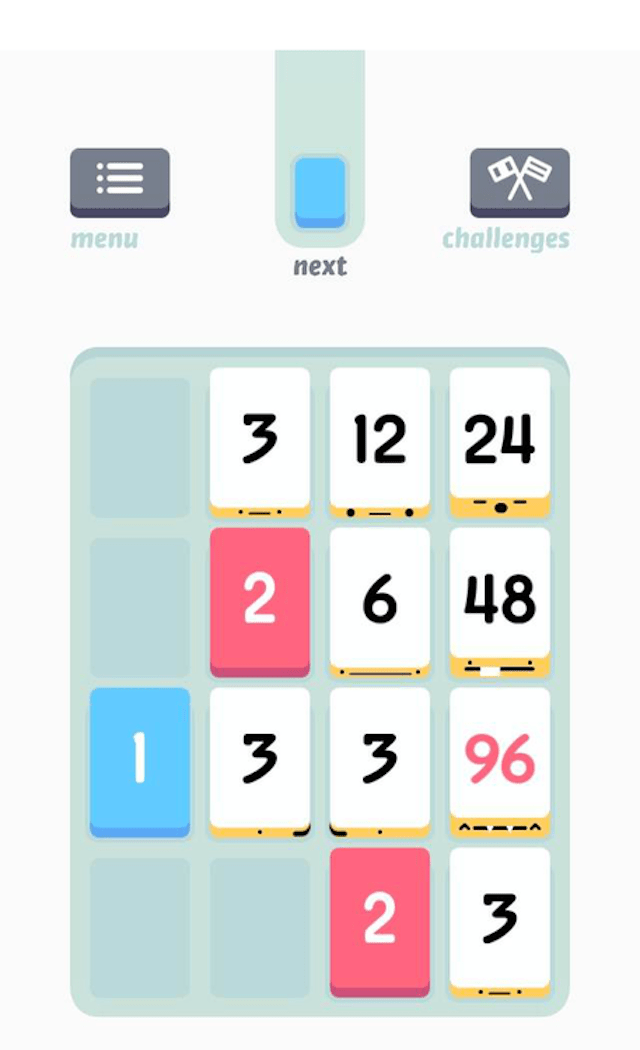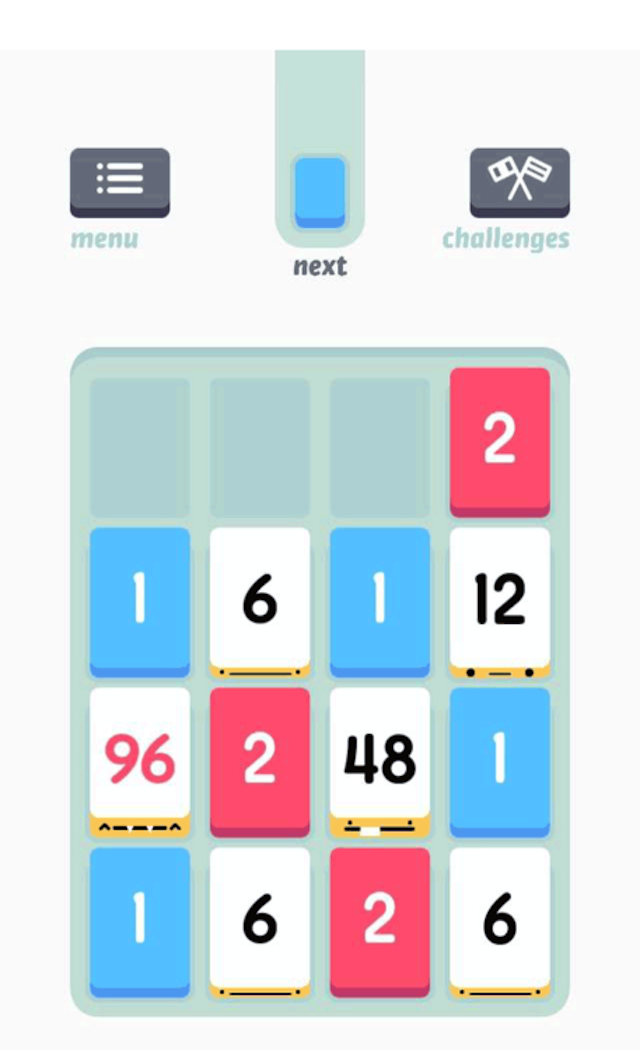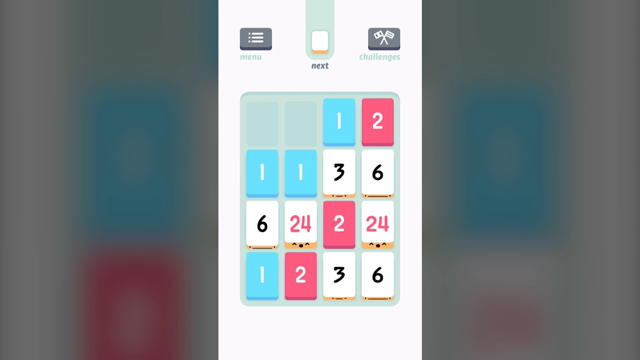A bunch of us here at Kotaku are deep in thrall to Threes, a simple-on-the-surface-but-hypnotically deep numerical puzzle game that hit iOS devices last week. (Seriously, look at that picture. We’re not even talking to each other.) There was talk of doing our own guide to playing Asher Vollmer’s hit game but it came to light that an excellent set of hints already exists. If you’re playing Threes, you need it in your life.
Game designer Ryan Clark — who’s the mind behind the upcoming action-RPG/dance game Crypt of the Necrodancer — has also been caught in the grip of Threes. As someone who also makes games, Clark’s guide to Threes offers up some unique insights that most players may never figure out themselves. Heck, it’s already changed the way I play. We’re re-printing the entire thing here on Kotaku with Clark’s permission. Get ready to make some 384s!
Hi folks!
So if you haven’t yet played Threes (elegant new iOS game by three excellent devs, Asher Vollmer, Greg Wohlwend, and Jimmy Hinson), you should download it right now! It is the best iOS game I’ve ever played.
In this post I will enumerate my Threes strategies. My highest score so far is 28,077, and I was briefly at 5th place on the all time leaderboards 🙂 I regularly score in the high 20,000s and I believe that it’s the strategies below that enable me to do so. I hope they bring you similar success! On to the good stuff:
In Threes, you never have more than four options: Swipe left, right, up, or down. When making your choice there are two things I think you should do:
- Think about the incoming card, and what cards are likely coming after it. (More on how to predict upcoming cards, below.)
- Think about the board, attempting to leave it in a state with maximal “good” and minimal “bad”.
Here are my guidelines for what makes a situation “good” or “bad”:
THE GOOD

- It is good to create a highway of ever increasing number sizes. (Check out the great highway, above! 3->6->12->24->48->96.) Highways are the most surefire way of generating your next goal number without having to travel (attempting to join two cards that are far apart on the board). In general, try to keep large numbers adjacent to their halves. (If you have a 384 and 192, try to keep them close together. That way when you finally create a second 192 and combine it for a second 384, you can immediately combine the two 384s without having to do too much travelling.)
- The more empty space you have, the healthier your board is. (To create the larger numbers you will need room for MANY smaller numbers in your highway!) Each turn a new card is added to the board, so if you are not matching something each turn you are losing space. This can be ok if you have a plan for regaining that space later, but do not fill up space without a plan! Additionally, you can regain space when you make multiple matches in a single move. Most of the time, this is quite beneficial!
- If you’re starting to run out of space, try to ensure that you still have all 4 degrees of freedom (the ability to still swipe in all 4 directions). When you’re down to just 2 degrees of freedom, you’re almost completely at the mercy of the random selection of upcoming cards. Sometimes you’ll manage to pull out of it and survive, but it’s not wise to tempt fate too often!
- “The Corner Strategy”: It seems to be optimal to protect your largest numbers by keeping them in (or near) a corner. This helps prevent the situation where you have small numbers “stuck” near your large ones, wasting space. Try to keep your large numbers in that corner unless you are starting to run low on space (ie. less than 4 or 5 empty tiles). At that point it may be more valuable to prioritise the board’s long term health.
- If you’re unable to pursue the Corner Strategy at any point, it is still beneficial to mentally compartmentalise the board into your “small number area” and your “large number area”. In general, any incoming cards should be pushed into your small number area where they can combine to form your next goal number.
THE BAD

- You do not want to see bignumber/smallnumber/bignumber. (Greg Wohlwend calls this checkerboarding.) A board like this is very bad! This is the opposite of a highway and it can disrupt your ability to smoothly flow from small numbers to large ones without the need for travelling. Blocked boards like this can also reduce the degrees of freedom available to you.
- Try to avoid having more than two of a given large number around. It is not helpful to have three 192s sitting around! (Or even three 96s, 48s, etc.) You should always have a number that you’re working towards, and as soon as you obtain the components required to generate that number, you should ideally attempt to match those components together. Doing otherwise clutters up your board and reduces space. And since space is equivalent to health, you need to keep your board as efficient, clean, and healthy as you can. For each successive large number you’re attempting to create, you’ll require one additional board space for the manufacturing process. (A 6 requires two spaces for the two 3s you need. A 12 requires three spaces for the 6 and two 3s you need. etc.) If you want to generate higher numbers and higher scores, you need all the space you can get!
THE UGLY
Here’s a breakdown of the algorithms the game uses to decide the type, value, and placement of the incoming cards. Having a good grasp of these algorithms will help you to plan ahead with greater confidence:
- The location of the incoming card is dictated by the rows or columns that MOVE when you swipe. If only one column or row is moving during a swipe, the incoming card *will* necessarily appear in that column or row. If two or more columns or rows are moving during a swipe, the card will appear in one of those moving columns or rows, chosen at random. (Thanks to Matt Rix for that tip!) Remember: You can test to see which columns or rows will move by swiping but not taking your finger off of your device. Do this prior to each move to ensure that you’re not surprised by the location of the incoming card!
- This thread over at Touch Arcade is gold mine of Threes information. In particular, kamikaze28 has done some amazing work to uncover the patterns behind the selection of the colour of the incoming card. I first hypothesised that Threes was using some variant of Tetris’s “grab bag” algorithm to select the incoming cards, and kamikaze28 began collecting data from people in that thread and analysing it with the “grab bag” theory in mind. It seems that the game makes a “stack” of twelve cards containing four 1s, four 2s, and four 3s. It then gives you a card selected from that stack at random. When the stack has run out, a new stack of twelve is created and you begin again. This means that in any 12 card sequence you will always see four of each colour of card. Additionally, this means that you could theoretically see up to 8 of the same colour in a row! (This could occur at the end of one stack and then the beginning of the next, though it would be quite improbable. The most I have seen is six of the same colour in a row.) This knowledge can help you in a few ways. First, if you’ve been seeing a lot of a certain colour, you know that the probability of that same colour coming up again next is lower. Second, if your board has numerous blue (or red) cards on it, you can be certain that the corresponding red (or blue) cards will be coming soon. (This is because there are always the same number of each colour in the “stack”. For each red or blue on the board there is a matching card coming up within the next 11 cards or fewer.)
- Ah, but the developers couldn’t let it be that simple, could they? You mave have noticed that the game occasionally gives you a white card that is not a 3! It seems that these non-3 white cards are 1/8th the value of your highest value card, or lower. So if you have a 48 on the board, you may begin to see the occasional 6 card. If you have a 96 on the board, you may see 6s or 12s. It seems that these cards are occasionally inserted into the “stack”, making a stack of 13 cards in that case. It is not yet known what governs the timing of the game’s decision to insert a non-3 card, but it seems to happen in every other stack, on average. (Once in every 24 cards or so.) Again, credit for this goes to kamikaze28 from the Touch Arcade forums!
ASSORTED TIPS
- I find that, as I improve, my games take a lot longer than they used to. To mitigate this time sink, I now start every game by repeatedly swiping RIGHT and then DOWN. Do this enough times and you will usually end up with a 48 in the bottom right corner, and sometimes even a 96 or higher, before you start to get into “bad” situations that require more intelligent behaviour. And even then, sometimes all it takes is a few RIGHT, RIGHTs or DOWN, DOWNs and you’re back on track. Doing this also seems to be a helpful exercise in terms of seeing how the numbers naturally “want” to stack.
- Whenever I lose it’s either because of checkerboarding or superfluous large numbers (three or more of a given large number on the board, taking up space needlessly). I touched on both of these things above, but wanted to emphasise they they are the ONLY causes of failure in this game! Learn how to see them coming and your scores will improve.
- Occasionally you will need to travel (move one number some significant across the board so that you can merge it with another). My current method of doing this is as follows: First, you must un-align the two cards that you wish to merge. If they are in the same column or row, you cannot move them toward each other! Second, you must shift the rows or columns containing these two cards relative to each other. To achieve this you must block one of the rows or columns such that it cannot slide while still allowing the other row or column to still slide freely. Then slide the two numbers closer together. Your board is usually composed primarily of white cards, so red/blue cards are good at forming “blocks” for this manoeuvre.
- You need to develop your “highway vision”. Always be thinking about your goal number and subgoal numbers and how the numbers near them can be made into a highway. If there’s a low-number card nearby, how can you get rid of it? If you can’t get rid of it, how can you bring other low value cards to that spot to merge them into more useful higher value cards? You should always be thinking about short term mini highways (3->6->12->24) and longer term highways that will get you the big scores.
- When you’ve only got 2 or 3 free spaces left on the board it’s likely time to shift into emergency mode. (Unless you’ve already got a nice highway set up and you’re about to execute it!) When you’re in emergency mode your priorities are to maintain all 4 degrees of freedom and to find ways to line up swipes that make multiple matches. Only a multiple match will result in a net gain of empty space! Mini highways can be quite helpful during emergency mode. Try to find paths that will take you from 3 to 6 to 12. Usually as you do this some other match will also become available and you’ll have the shot you need at a multiple match.
In conclusion, Threes is a game of balancing risks. You must balance short term risk (the need find ways of accepting the incoming numbers without losing space) with long term risk (the fact that if you don’t merge your large numbers you will end up with too many duplicates taking up space). I hope that these strategies will help you to balance those risks and surpass me on the leaderboards 🙂 Good luck!
Friend me on Game Center if you’d like to compete! My id is “SlopeOak”.
See any problems or have any tips of your own to share? Let me know!

Comments
8 responses to “Tips For Playing Threes, The New Mobile Game Everyone’s Talking About”
I like to think I know more than 0 people (indeed – facebook tells me I know atleast 234 people since I only add people I’ve met) and not one single person has talked about this – and I know that some of those 234 people talked endlessly about Candy Crush and Flappy Birds
Same here. I’ve only seen one, maybe two other articles about this game on other sites purely saying that it exists and is a thing. I haven’t even heard anyone at work talking about it. The only reason I know it’s popular is because Kotaku says so.
Oh Kotaku, if only you got a dollar for every Threes article you run you could ease up on the click-bait and one liners.
It certainly seems you should be getting paid for your Threes work.
5 articles for Threes in the last two weeks. 12+ for Titanfall in the same amount of time. 5 articles for Threes in total. Likely over 100 for Titanfall.
Titanfall has a crazy enormous marketing budget (larger than your total lifetime earnings most likely) and doesn’t need Kotaku’s help spreading the word for it to be a success. Threes has word of mouth and articles like this to help spread the word. Every articles counts for Threes.
And it is a brilliant game, one that I wouldn’t have even known about it if it wasn’t for Kotaku. For all the attention Flappy Bird got, it’s nice to have a quality mobile game get some love.
Of course Titanfall has a bucket of articles – you really shouldn’t compare these two. Like the other posters i have only heard of Threes here. It sounds like it will make a few ‘great games’ lists, hopefully people will play it and it will be noticed.
Now see the list of articles and re-read the titles.. http://www.kotaku.com.au/tags/threes/ ..wow, rivetting stuff. The frequency of these not-news but rather most-wonderful-thing-i-have-ever-discovered articles is what i have a problem with – not the size, quality or advertising budget of the game. Drilling pretty ordinary information about a game at me does not keep me interested, it makes me switch off. If this game keeps popping up from time to time as good games do I’ll be more likely to check it out.
I don’t understand. I’m not being facetious, I just honestly don’t understand what you actually have a problem with. This is a news site for games, one of the types of articles on a site like this is to recommend games to people that they might not have heard of.
What do you mean, of course Titanfall has a bucket of articles and I shouldn’t compare them? Titanfall has a bucket load of articles because there’s an eight or nine figure marketing budget pushing the game down everybody’s throat – Why is it okay that a game with money behind it get’s dozens of articles, on such inane topics as “This Gentleman Is Upset He Was Not Invited To Titanfall’s Alpha (NSFW)”, why is that considered something that is worthwhile, but less than half a dozen articles recommending an indie game are beyond the pale? It’s one article every two or three days, on a site that publishes probably two dozen articles each day. It’s a good game, I’m glad it’s getting exposure.
I’ve actually spent a few hours playing Threes, and this article of tips is exactly what I was looking for before I read it. Isn’t there some commonly agreed upon etiquette that if an article doesn’t interest you, you just ignore it, rather than taking the time to make a snarky comment? I thought that was a thing.
Tell me when it comes to a real phone.
Reads like an advertorial. And, yes, that’s a real thing.
Also, the amount of discussions about Flappy Bird is telling – in regards to how good or bad a game it is. The amount of discussions about Threes is also telling.
It’s a great game. These tips are great. If it ever comes to Android/Windows phone I can highly recommend it.
Enough with the snark, save your energy for things that are actually worthwhile.